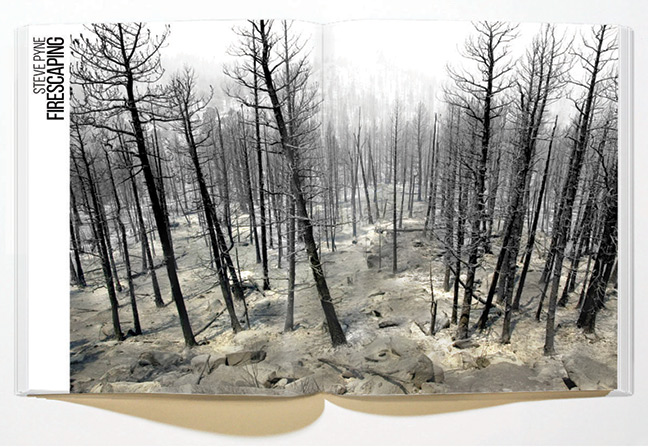
PennDesign’s landscape architecture journal, LA+, imagines unique scenarios—with an interdisciplinary spin.
Eco-terrorists have invaded Central Park, unleashing robotic insects that stripped its trees and gobbled up its plants. Any remaining shreds of foliage have been razed. Suddenly, New York City must rebuild its iconic outdoor space from scratch.
It’s a startling image—the world-famous park without its greenery—but Penn’s landscape architecture journal, LA+, likes to startle. Since 2015, it’s been publishing twice-yearly print issues, each built around a sweeping theme: Pleasure; Identity; Imagination; or in the case of its Central Park redesign competition, Iconoclast. Those themes are then examined from all angles through essays, interviews, design criticism, and illustrations—and the people who examine them often work far outside design studios.
“LA+ started because designers are very good at speaking to one another, but they tend to only speak to one another,” says Richard Weller, chair of landscape architecture at Penn and the journal’s creative director. “This is a journal where designers aren’t just talking to other designers.”
Consider the contributor list in the most recent issue, LA+ Time. It includes several landscape architects but also a social anthropologist, a professor of geography and environmental systems, and an ecologist. As Weller sees it, in order for a landscape architect to responsibly design large areas in cities or beyond, “you need to take in information about society, economy, ecology, culture,” he says. Hence the multidisciplinary approach of LA+.
The journal also devises juried design competitions, including the one last fall to remake Central Park. The goal is partly to generate content for its print issues but also to help kickstart creative brains. Weller says that 394 people entered proposals to redesign the park. The winners will appear in the Fall 2019 issue, LA+ Iconoclast. The journal’s last competition, centered on designing a fictional island, prompted about 140 entries from 32 countries.
“Students have some freedom while they’re studying, but then they graduate and go into a profession that is tightly constrained by reality and economics,” Weller says. “To advance, design culture needs oxygen. LA+ is intent on providing that.”
Weller spoke with Gazette contributor Molly Petrilla C’06 about his long-term vision for LA+, some of its most surprising contributors, and the significant role that PennDesign students play in the production process.

Your contributors come from many different disciplines, but who is the primary audience for LA+?
Landscape architects, urban designers, urban planners—people involved in making and shaping cities. It’s not a trade journal. It’s also not overly academic. But it’s definitely for the thoughtful practitioner.
What’s been the most surprising discipline to appear in LA+ , considering that it’s a journal rooted in landscape architecture?
We’ve had a couple of articles from people involved in neuroscience. They’re interested in cognition of urban space and environment, and how we respond to those environments due to certain triggers.
What role do PennDesign students play in producing the journal?
The chief editor [Dr. Tatum L. Hands] is an external professional who runs the whole project. But the journal is produced in the [design] school with groups of students. Every page, all the graphics—everything is designed and laid out by the students under our direction. We have teams of up to four people for each issue. They work right through the process from start to finish and deal with the question of interpreting the written word and translating it into visual information.
We don’t just pop in illustrations to give pictures to an article. We will often do original mapping or drawing—graphic work that’s specific to what the author is saying. Each student gets a text from an author. Students will do five or six [design] variations on each article. Then we all get together, pin it up on the wall, and have critical review sessions. We all agree on a final approach.
How did you tackle the challenge of launching a brand-new print journal? That’s a big undertaking, especially at a time when print media is struggling.
Often people said to us, “Why are you doing this now when everything is digital? Why would you bother producing a print journal?” We’re well aware of what’s going on with digital culture, but we thought there was still a need for a beautifully produced publication. We conceived of the journal as a collectible item with a lot of attention to detail and aesthetics. We also didn’t set out to make a profit. If it was a commercial venture, it wouldn’t work.
How do LA+ ’s juried competitions like the Central Park redesign or the imaginary island build—things that won’t happen in real life—help advance the design profession?
You get a snapshot of what the global design community is thinking when they’re not constrained to servicing real projects. You can see what’s going on, and it gives you a fascinating cultural insight. With Central Park, we asked entrants to think about politics, public health, and emerging ideas of nature.
What are some of your longer-term goals for LA+ ?
People are reluctant these days to subscribe to journals. It’s very difficult to build up your audience. Online, it’s much easier. We’ll be considering how we adapt the journal into a digital version. We won’t forsake print, but we’ll do both in the future. The question will be how we maintain the print run but also move to a digital platform so it’s cheap and globally accessible.




